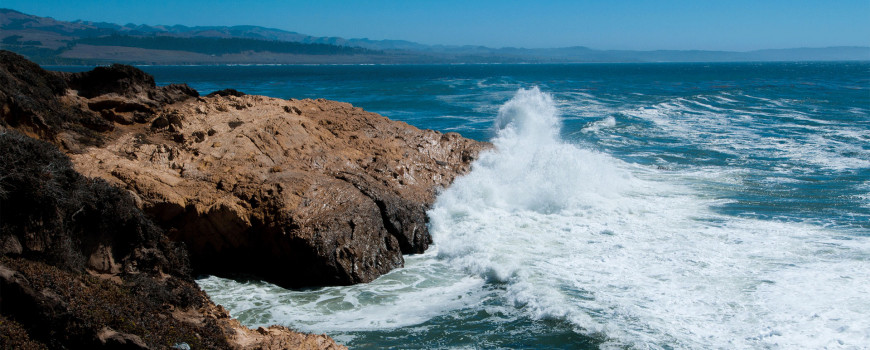Together, the California State University Council on Ocean Affairs, Science and Technology (COAST) and California Sea Grant, have awarded $1.1 million to support sea-level rise research through COAST’s State Science Information Needs Program (SSINP). Three awards will support 11 researchers and over 20 students at six different CSU campuses.
The three selected projects cover a range of issues for which the state of California is seeking additional natural and social scientific information. Dr. Kiersten (Kiki) Patsch of CSU Channel Islands (CSUCI) will lead a team to investigate how sea-level rise will affect coastal access for underserved populations. The team will integrate this information into an existing beach sustainability database that can be used by the California Coastal Commission and other state agencies to make management decisions. The project, entitled “Sustaining Beaches and Social Equity under Higher Sea Levels: An interdisciplinary case study of the Santa Barbara Littoral Cell” was awarded $396,060 and involves Dr. Dan Reineman (CSUCI), San Francisco State University faculty members Dr. Phillip King and Dr. Nina Roberts, and Dr. Charles Lester from UC Santa Barbara.
Dr. Ben Hagedorn (Cal State Long Beach) and colleagues will identify areas where sea-level rise is causing groundwater to rise and mobilize toxic substances from contaminated sites. Dr. Hagedorn and his colleagues will then explore in more depth the mobilization of contaminants in one to two low-income areas of the state. The project, entitled “Impact of Sea-Level Rise on Groundwater Pollution Vulnerability in Shallow Coastal Aquifers” was awarded $210,755 and involves Dr. Matt Becker (Cal State Long Beach) and Danielle Bram (CSU Northridge).
Dr. Danielle Zacherl (Cal State Fullerton) and colleagues will assess whether nature-based adaptation approaches can protect adjacent shorelines from erosion, which will increase as sea-levels rise. Specifically, the team will study an existing project where oyster shells and eelgrass were placed on the shoreline in Upper Newport Bay, Orange County. The project, entitled “Development of Cost-effective Metrics for Monitoring Living Shorelines” was awarded $390,165 and involves Dr. Joe Carlin (Cal State Fullerton), Dr. Luke Miller (San Diego State), Dr. Christine Whitcraft (Cal State Long Beach), and Katie Nichols (Orange County Coastkeeper).
All research teams will consult with state of California agencies as they begin their projects so that the results are as useful as possible to the state. “COAST worked closely with us and the rest of California’s coastal management agencies to develop this suite of studies,” said Sam Schuchat, Executive Officer of the State Coastal Conservancy. “We look forward to applying the results to benefit all Californians.”
“This is tremendous news,” said California Coastal Commission Executive Director Jack Ainsworth. “Determining which areas of the coast are particularly important to underserved communities will be critical as we continue to plan for how best to protect our coast for all Californians. This information will also help to ensure that we are factoring equity and environmental justice into sea level rise planning and will help inform communities as they continue to grapple with the challenging decisions ahead.”
Funding for the COAST SSINP comes from a one-time $3 million state appropriation to the CSU for research that supports the state of California’s ocean and coastal science needs. “We are delighted to fund research that is directly applicable to state needs, while providing experiential learning and workforce training for our students,” said Dr. Krista Kamer, COAST Director.
For the sea-level rise awards, COAST contributed $800,000 and California Sea Grant provided an additional $300,000. “We are excited to leverage our federal Sea Grant funds to support research that will inform science-based management and decision-making to help California’s coastal communities adapt to sea level rise,” said California Sea Grant Director Shauna Oh.
Project summaries can be found on COAST’s website.
# # # #
About the CSU and the Council on Ocean Affairs, Science & Technology
The California State University is the largest system of four-year higher education in the country, with 23 campuses, nearly 56,000 faculty and staff members, and over 485,000 students. Created in 1960, the mission of the CSU is to provide high-quality, affordable education to meet the ever-changing needs of California. One in every 20 Americans holding a college degree is a graduate of the CSU and our alumni are 3.9 million strong.
The CSU Council on Ocean Affairs, Science & Technology (COAST) promotes research and education that advance our knowledge of marine and coastal systems. COAST has over 500 members from throughout the CSU working to inform solutions for ocean and coastal issues at multiple scales.
About California Sea Grant
NOAA’s California Sea Grant College Program funds marine research, education and outreach throughout California. California Sea Grant is headquartered at Scripps Institution of Oceanography, University of California, San Diego, and is one of 33 Sea Grant programs in the National Oceanic and Atmospheric Administration (NOAA), U.S. Department of Commerce.
Adapted from CSU release by Amy Vierra

